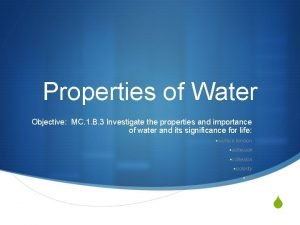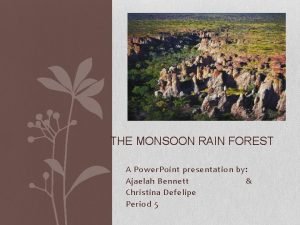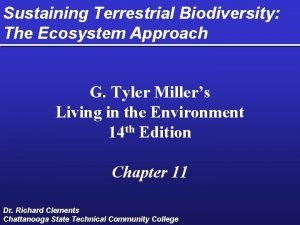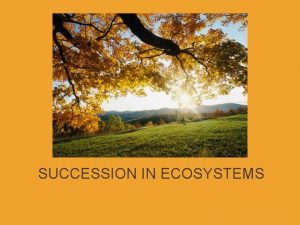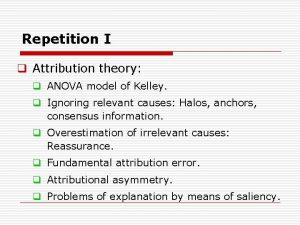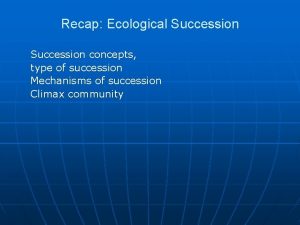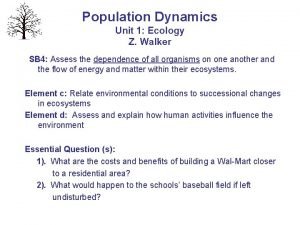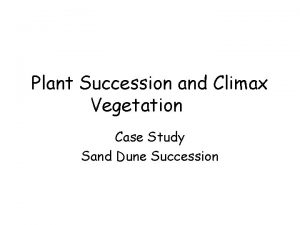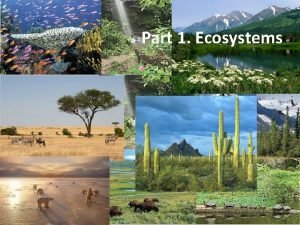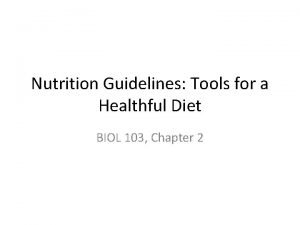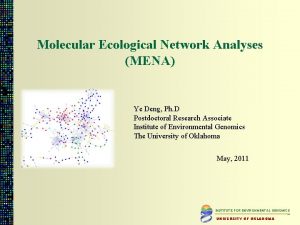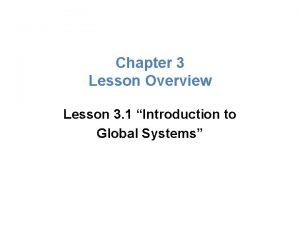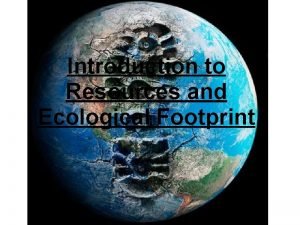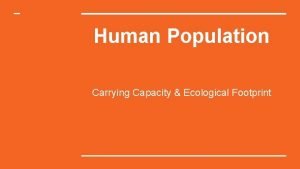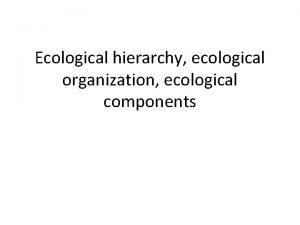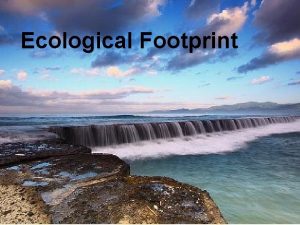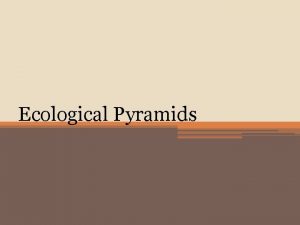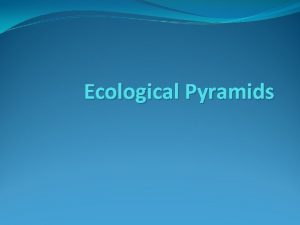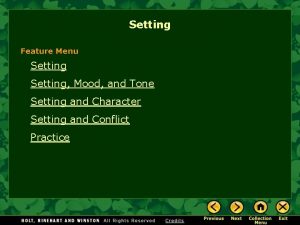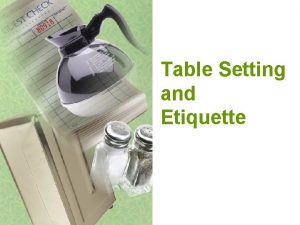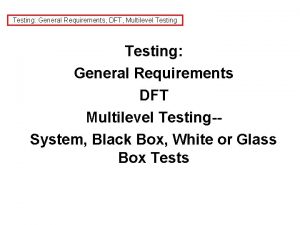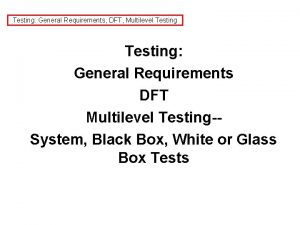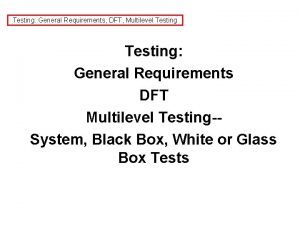ECOLOGICAL WATER REQUIREMENTS general ECOLOGICAL WATER REQUIREMENTS Setting





























- Slides: 29

ECOLOGICAL WATER REQUIREMENTS general

ECOLOGICAL WATER REQUIREMENTS Setting flow requirements that maintain HABITAT for instream and riparian biota at a specified state. Very simply – flow & its associated characteristics (water quality, sediment, patterns) that should be left or provided in the river system for biota dependant on it as well as any people dependant on a natural functioning river (Goods & Services). TWO PROCESSES: Eco. Classification: Determining Present state, importance and future state Quantifying the volume required

ECOLOGICAL WATER REQUIREMENTS Eco. Classification

What is Ecological Classification? Eco. Classification consists of 3 processes: Ø Present Ecological State (PES) The PES describes the river according to ecological status or health compared to natural conditions Ø Ecological Importance The EIS evaluates and rate a range of criteria to determine an overall importance (Low to Very High) Ø Recommended Ecological Category (REC) The REC is an improved PES (if the PES is low) motived by a High of Very High importance

ECOCLASSIFICATION (slide 2) The process can be described in terms of a range of questions: What state do you want your river to be in future? To answer this, you need to know: Ø What state it is in now? Ø Why is it in that state? Ø What is important about your river (ecological and socio-cultural)?

ECOCLASSIFICATION (slide 3) Steps in Eco. Classification: Ø Estimate the natural condition (the “A”). Ø Evaluate human impacts & describe how it has influenced the ecological state. Ø Identify whether changes are related to flow or other factors. Ø Determine the Ecological Importance and Sensitivity (EIS). Ø Recommend the Ecological Category to aim for (REC).

ECOCLASSIFICATION (slide 4) Detailed approach for each EFR site and reach Present Ecological State: FIRST: Have to know what state your system drivers are in. System drivers are hydrology (key), water quality, geomorphology SECOND: Need to know how the response biota respond to the changes in drivers. Response biota for rivers are fish, bugs (invertebrates), riparian plants and diatoms THEN THE RESPONSES IS INTEGRATED TO GIVE THE ECOLOGICAL STATUS OF THE RIVER - ECOSTATUS

ECOCLASSIFICATION TOOLS (slide 4) Models that measure the state that each of the drivers and the response biota is in. Models provide the state in terms of A – F Natural Changed completely Hydrology: Reference hydrology, present hydrology – how much has it changed. Geomorphology: Reference substrate, shape of channel, sediment transport – how much has it changed. Water quality: Nutrients, p. H, Oxygen, Temperature, Salts etc.

ECOCLASSIFICATION TOOLS (slide 5) Fish and invertebrates: Ø Identify species that would be there under reference condition. Ø Identify species that is present now. Ø Identify how sensitive the species are to changes in flow, sediment and water quality – i. e. if only tough species are left and sensitive ones have disappeared, then one can assume that the drivers have been impacted on. Riparian vegetation Ø Identify how riparian vegetation has changed from reference by looking at the impacts. Ø Look at riparian vegetation in terms of cover, abundance, exotics. Ø Measure in terms of woody and non-woody and for marginal and non-marginal areas

EFR 2: ASSEGAAI Driver Components HYDROLOGY WATER QUALITY GEOMORPHOLOGY Response Components FISH PES D Upstream dams, forestry, abstractions Nutrients, salts B/C B Decreased sediment transport capacity, less floods PES C AQUATIC INVERTEBRATES B/C INSTREAM B/C RIPARIAN VEGETATION C ECOSTATUS C Fish species missing, abundances, diseases, trout Bugs missing, abundances, some sensitive groups Exotic vegetation, erosion, grazing

ECOCLASSIFICATION TOOLS (slide 7) Ø Ecological Importance and Sensitivity (EIS) is evaluated using similar models to determine Very High, Moderate and Low Importance. Ø Based on the outcome of the EIS, the Recommended Ecological Category (REC) can be derived as follows: § If Importance is High or Very High – the REC should be improved if the PES is lower than a B. Ø NB: need an indication whether flow, water quality or land use/catchment activities must be improved. Ø The PES assessment which identified the reasons is NB.

PES AND REC ECOSTATUS EFR 1: NGWEMPISI EFR 2: ASSEGAAI EFR 3: MHKONDVO PES C EIS = HIGH EIS - MODERATE REC B/C REC C

Rivers with lots of problems Spekboom Mhlathuze Ingwavuma Lusushwane

Rivers with less problems – reasonable condition Lusushwane Maputo Mkondvo Ngwempisi

ECOCLASSIFICATION AND EWRS Ø Eco. Classification is a process with associated tools. Eco. Classification can be used as a stand-alone process for other uses such as in EIAs etc. The EWR process always includes Eco. Classification and cannot stand on its own Links in process as follows: Ø 1. Set flow requirements for different ECs Ø 2. Test other flow requirements to determine impact on EC Ø 3. Set monitoring objectives in terms of EC Ø 4. Measure monitoring results against desired EC 31

ECOLOGICAL WATER REQUIREMENTS how

ECOLOGICAL WATER REQUIREMENTS (slide 1) Now to know what state you want your river to be in and you need to know what you must do to keep or get your river in that state. Ø How much flow does your river need? v Which flow regime will provide suitable habitat (water quality and geomorphology) for the animals and plants dependant on the river? v Will the above be suitable to maintain or improve the Goods and Services? v Are there other flow regimes that will also result in an acceptable state (and with less impact on the users)? v Are there non-flow related problems that must be addressed at source so that you do not use water to mitigate those problem?

ECOLOGICAL WATER REQUIREMENTS (slide 2) How do we determine EWRs? Ø Determine low flows (base flows) & Ø high flows (floods) in different seasons and different conditions (droughts, normal, between etc) flow HIGH FLOWS LOW FLOWS

ECOLOGICAL WATER REQUIREMENTS (slide 3) flow NORMAL PERIOD 60% Oct (end of dry season) Dec to March Wet season May to Sept Dry season flow DROUGHT PERIOD 90% Oct (end of dry season) Dec to March Wet season May to Sept Dry season

ECOLOGICAL WATER REQUIREMENTS: LOW FLOWS (slide 4) Ø Determine the instantaneous flows for each month for normal years and drought years. Ø Based on the fish and bugs’ habitat requirements Ø Habitat requirements: Depth, velocity, substrate, cover, marginal plants, overhanging plants.

ECOLOGICAL WATER REQUIREMENTS: LOW FLOWS (slide 5) FISH Some fish cannot live without flowing water -other fish can survive in pools -BUT need enough depth to move from one place to feed and to breed; Need place to hide from enemies (birds, other fish, anglers) BUGS Depth not always as important; BUT need velocity and very specific substrate and marginal vegetation

ECOLOGICAL WATER REQUIREMENTS: HIGH FLOWS (slide 6) GEOMORPHOLOGY Ø Maintains the river channel. Ø Moves the rocks and sand Ø Cleans the rocks – open spaces for bugs and small fish to live in. RIPARIAN VEGETATION Ø Needs floods to clear out rubbish and undergrowth Ø Deposits nutrients and sediments (soil) Ø Supplies moisture in the soil/groundwater THEN

ECOLOGICAL WATER REQUIREMENTS: RESULT (slide 7) High flow EFR LOW FLOWS Low flow EFR days

ECOLOGICAL WATER REQUIREMENTS: (slide 8) CHALLENGES WHEN DETERMINING EWRs Ø Lack of information from hydrological and quality monitoring Ø Limited understanding of some species habitat requirements Ø NBNB: know the habitat requirements, but do not know the duration it requires – or how often it can handle bad conditions before it cannot bounce back (eg drop a category) All users’ flow requirements are provided as a volume linked to assurance of supply Same for EWR – i. e. Compatible

ECOLOGICAL WATER REQUIREMENTS: (slide 9) Where do HYDRAULICS fit in? It has to do about flow RATE (not volume) and it is used to translate habitat requirements (expressed in terms of hydraulic parameters – width, depth, wetted perimeter, velocity) to FLOW. Get hydraulics wrong – everything = wrong

ECOLOGICAL WATER REQUIREMENTS: ESTUARIES Ø Principles are the same. Ø Eco. Classification similar process for estuarine drivers and responses Ø EWR method top-down– i. e. , respond to scenarios Ø Complex situation as one has thresholds with mouth opening and closing and marine conditions. Ø Problems with estuaries are often WWTW Ø Other problems are insufficient fresh water – mouth closing to much and then Ø ALL THE OTHER ANTHROPOGENIC ISSUES. Ø NB is link to DEA, DAFF etc regulations as well as Estuary Management Plans

ECOLOGICAL WATER REQUIREMENTS: WETLANDS Ø Principles are the same. Ø Eco. Classification process not well developed Ø EWR methods not well developed Ø Catchment approaches problematic due to number of wetlands and different types. Ø Floodplain wetlands (Nylsvlei, Pafuri eg) follow river methods. Hydrodynamics however complicated and expensive. Ø Important links to DEA regulations amongst others

ECOLOGICAL WATER REQUIREMENTS: LAKES Ø Few lakes in SA Ø Processes that do exist has rarely been used – linked to lake levels and frequency of inundation of riparian areas. Ø Many large lakes unique – needs specific approaches

ECOLOGICAL WATER REQUIREMENTS: GROUNDWATER Ø Original intent was to determine the groundwater component of the Ecological Reserve, i. e. Ø Of the EWRs, how much comes from groundwater so as to protect that component from being abstracted via groundwater. Ø Accepted process exists – in some ways controversial as focusses somewhat on determining allocatable groundwater. Ø Lack of understanding of dependence of ecosystems on groundwater – especially the groundwater which is not traditional – vadose zone (unsaturated zone). The vadose zone water often plays a major ecological role – but is not considered.
 Water and water and water water
Water and water and water water Understanding jim crow (setting the setting)
Understanding jim crow (setting the setting) Planos en cinematografia
Planos en cinematografia Where did general lee surrender to general grant?
Where did general lee surrender to general grant? Strong surface tension
Strong surface tension The chain
The chain Ecological importance of forest
Ecological importance of forest Secondary succession def
Secondary succession def What is case series
What is case series Ecological fallacy examples
Ecological fallacy examples Example of biological species
Example of biological species Relevant theory
Relevant theory Ecological succession concept map
Ecological succession concept map The ecological fallacy
The ecological fallacy Ecological amplitude definition
Ecological amplitude definition Average toe length graph
Average toe length graph Climax
Climax Ecological fallcy
Ecological fallcy The ecosystems
The ecosystems Ecological optics
Ecological optics Energy pyramid template
Energy pyramid template Ul tolerable upper intake level
Ul tolerable upper intake level Concln
Concln Chapter 3 lesson 1 introduction to global systems
Chapter 3 lesson 1 introduction to global systems Types of parasitism
Types of parasitism Edaphic factors
Edaphic factors Ecological footprint ap human geography
Ecological footprint ap human geography Importance of biodiversity
Importance of biodiversity Islandwood ecological footprint
Islandwood ecological footprint Ecological theory of development
Ecological theory of development




